
The Company
Topics
Contacts

nonwoven production line
Nonwoven is a product increasingly used in a wide range of areas, from personal hygiene to medical, from household products to industrial wipes. The production process is complex and comprises a series of phases which requires a careful management of the material to prevent loss of the basic characteristics and damage through, for example, wrinkles or folds.
Equally, nonwoven reels must be packaged and handled in the warehouse in a way that avoids any contamination and damage, to allow the product to reach the customer intact, just as it came out from the production line. Let us now see how to achieve this result in each phase, from the formation of nonwoven to the shipment of finished reels.
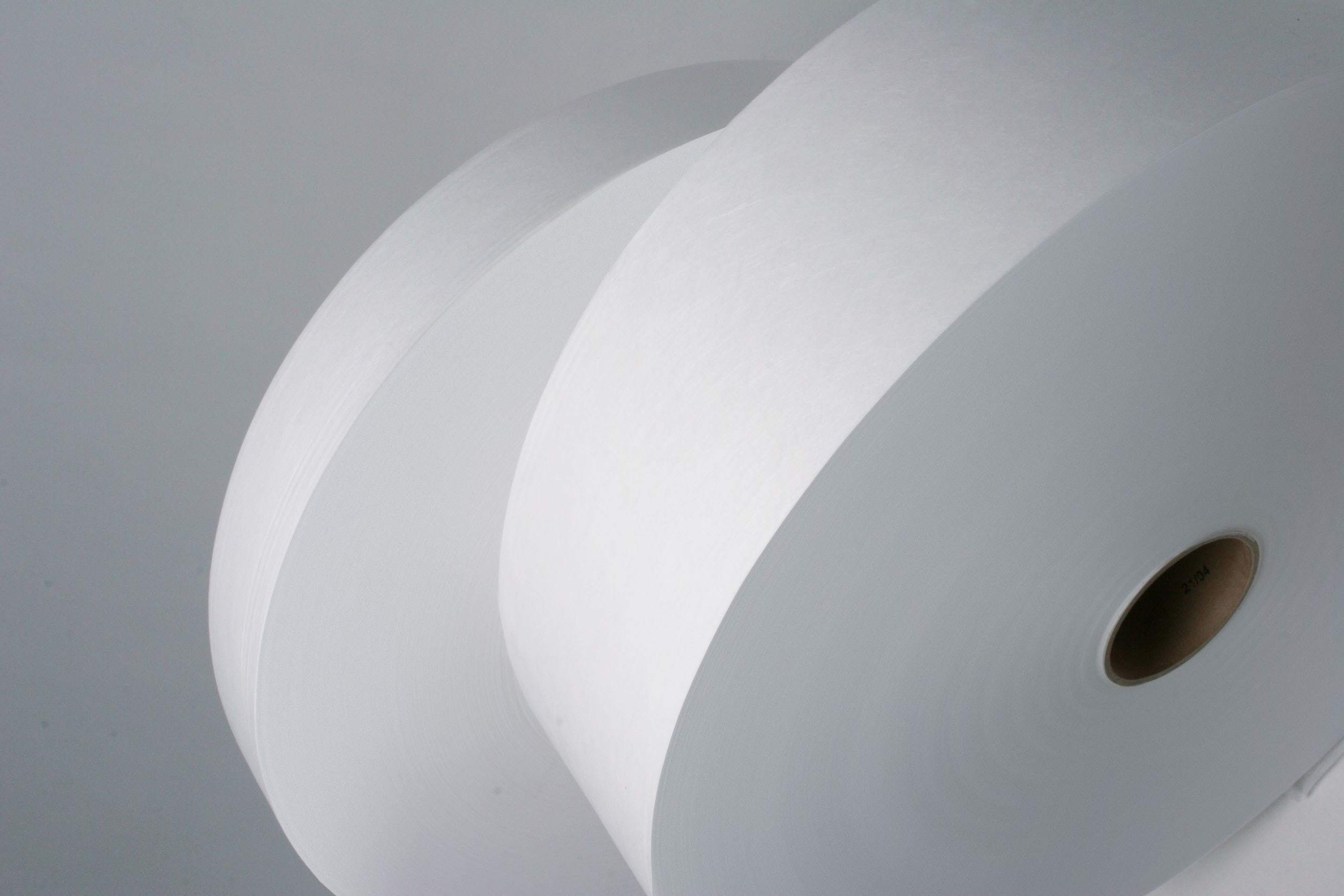
INDA and EDANA, the key associations for the nonwoven industry, define the product as a structure of sheets (or webs) held together by entangled strands by mechanical, heat or chemical processes. Such substrates are flat and porous sheets made from single fibres, melted plastic or plastic films. Nonwoven, as the name clearly implies, is not created through weaving and does not require the conversion of fibres into yarn.
The definition provided by INDA only describes the principle behind the production of nonwoven. Indeed, a variation in fibre selection, web formation, bonding and finishing creates products with their own characteristics and vastly different one from the other. This makes them suitable for use in numerous areas, such as hygiene-sanitary market, clothing, automotive, filtration, building and agriculture.
We can divide the technologies currently used to produce nonwoven into six types:
This method uses air to form a homogenous web composed by short fibres randomly oriented. The subsequent bonding of the fibres, deposited onto a conveyor belt permeable to air, can take place by using heat (TBAL), hydrogen (HBAL), latex (LBAL) or a mixed LBAL + TBAL process.
A thermal bonding process which involves the use of heated air on the surface of the nonwoven material, giving life to a bulky, soft, uniform material with a high resistance to traction. This process does not use chemical binders and it is the only type of thermal bonding process that submits the entire product to a uniform temperature.
Nonwoven obtained using a spinning process called “blow spinning”. The melted polymeric fibres are passed through a a spinneret to form long thin fibres, which are then stretched and deposited on a conveyor belt using hot compressed air, thus creating the web. Meltblown nonwoven are composed of extremely long, light-weight fibres and have high filtering capacities.
Nonwoven obtained using a bonding process for moist or dry fibrous webs obtained using carding, air-laying or wet-laying. The process, known as spunlace or “hydroentanglement”, uses fine jets of water at high pressure that penetrate the web, hit the conveyor belt and bounce against it, thus causing the entanglement of the fibers.
Spunlaid nonwoven (also called spunbond) are materials composed of extremely thin filaments. They are produced using a process that includes extrusion of polymers to form continuous filaments, which will be later conditioned, stretched and deposited onto a conveyor belt to create the web. The filaments will be chemically, mechanically, or thermally bonded to obtain the end product. Spunbond based on polypropylene is the predominant material for diapers and female hygiene products, as well as medical clothing.
The spunbond is often combined with meltblown nonwoven to create a layered product called SMS (spun-melt-spun). Made completely in PP, the SMS nonwoven are water repellent and can be used for disposable applications. Meltblown is often used as a filter material due to its ability to capture very fine particles.
Production technology similar to the one used in paper production. Nonwoven of this kind are distinguished from wetlaid paper because more than 30% in weight of their fibrous content is formed by fibres with a length/diameter ratio greater than 300, while the density is lower than 0.40 g/cm3. Wetlaid is commonly used to manufacture products such as tea bags, coffee filters and disposable wipes.
Among the key characteristics of nonwoven materials we can also find the elasticity, which leads to a progressive shrinking of the starting width of the web (neck-in) from the winding phase to the final product. In this regard, it is necessary to distinguish the specific characteristics of the two main types of nonwoven: spunlaid and spunlace.
Spunlaid, characterised by a random positioning of its fibres, it is more resistant to traction and, for this reason, it is subject to greater shrinking compared to spunlace. An initial web width of 3600 mm, for example, leads to final reels with a width equal to 3200 mm.
Spunlace, on the other hand, is composed by fibers oriented in Machine Direction (MD), due to the use of carding machines in the formation process. This makes it resistant to traction in that direction and, therefore, less prone to shrinkage.
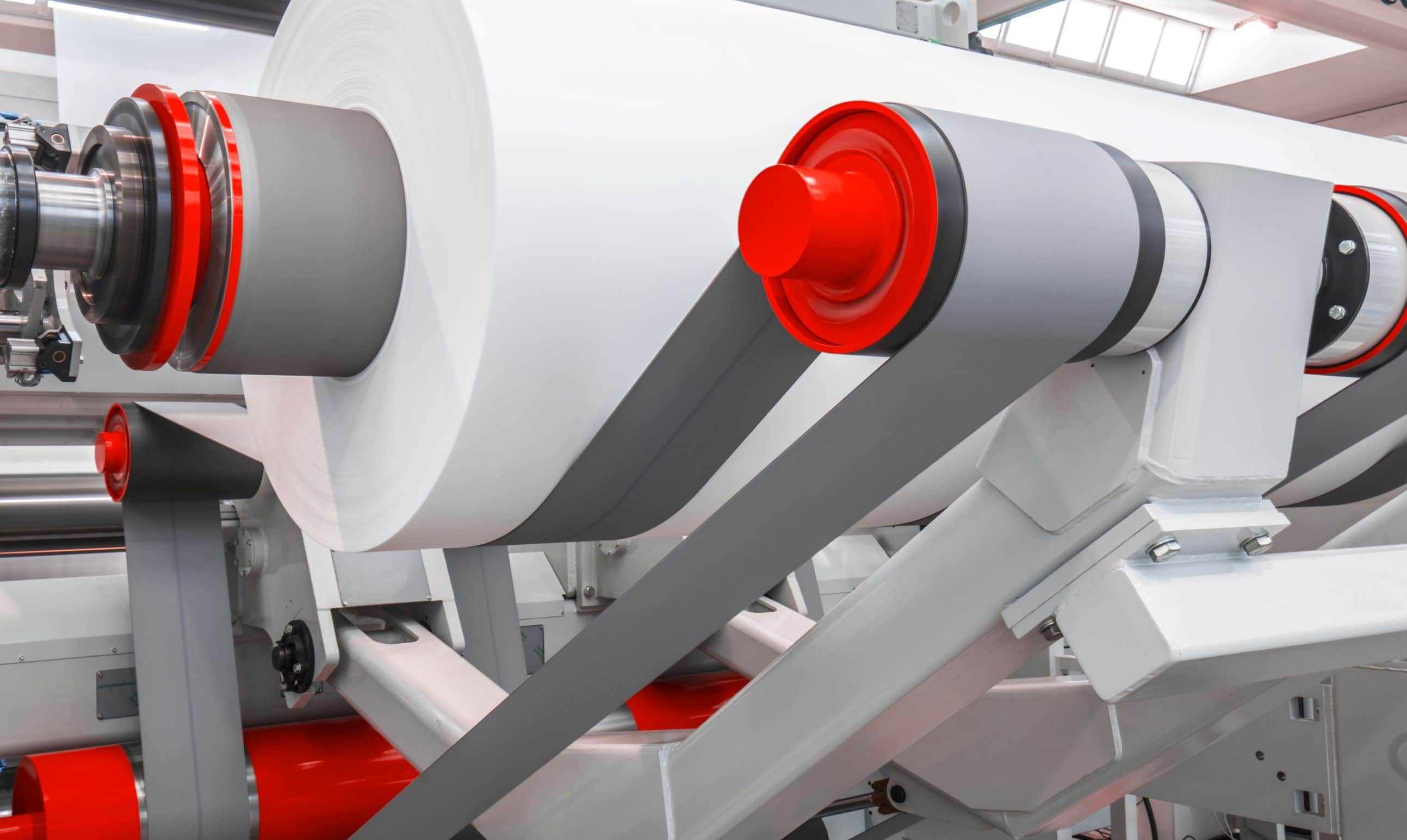
Following the formation of the nonwoven, the other essential component of the complex production cycle is the last phase: the so-called “end-of-line”. The winding, unwinding, slitting and rewinding processes take place here. Let us now take a closer look at the difference between the several types of machines used.
Machines with the purpose of creating a reel of large size and diameter called master roll (or Jumbo roll or mother roll) starting from the continuous web coming out of the production line.
Machines that take care of unwinding the incoming mother reel for subsequent processing of the web such as, for example, lamination, printing, the formation of nonwovens composed of several layers or, simply, to obtain final reels of smaller diameter and width (unwinder installed in the slitter rewinders).
The function of these machines is to cut, into the width desired by the customer (the converter), the master roll and wind the resulting strips of material to give life to a set number of reels with a smaller diameter and width.
During winding and rewinding, to obtain a flawless and high quality final reel, it is important to continuously monitor both the speed and TNT (Tension-Nip-Torque) parameters and follow several essential principles:
Also with regard to these processes, many issues can arise and risk affecting the final result. It is important to remember that, in general, errors in the setting of the TNT parameters can compromise the quality of the final reels, or even prevent them from winding.
The key defects are:
Lack of optimisation of the machine cycle times, such as the operations of master roll change, blades positioning, finished reel change, management of defects and, in general, all the operations which occur with the machine stopped, can cause poor speed and productivity.
Setting the slitting width must also consider the neck-in phenomenon, namely stretching of the material when the resulting strip is subjected to traction in Machine Direction by means of the carrying drums and wound around the cardboard core. In addition, attention must be paid to potential problems of radial or axial eccentricity, vibrations, slitting angle, lateral load and wear of blades.
For products intended for the hygiene market, it is essential that the powder created during the various rewinding phases is removed using dedicated systems to prevent contamination.
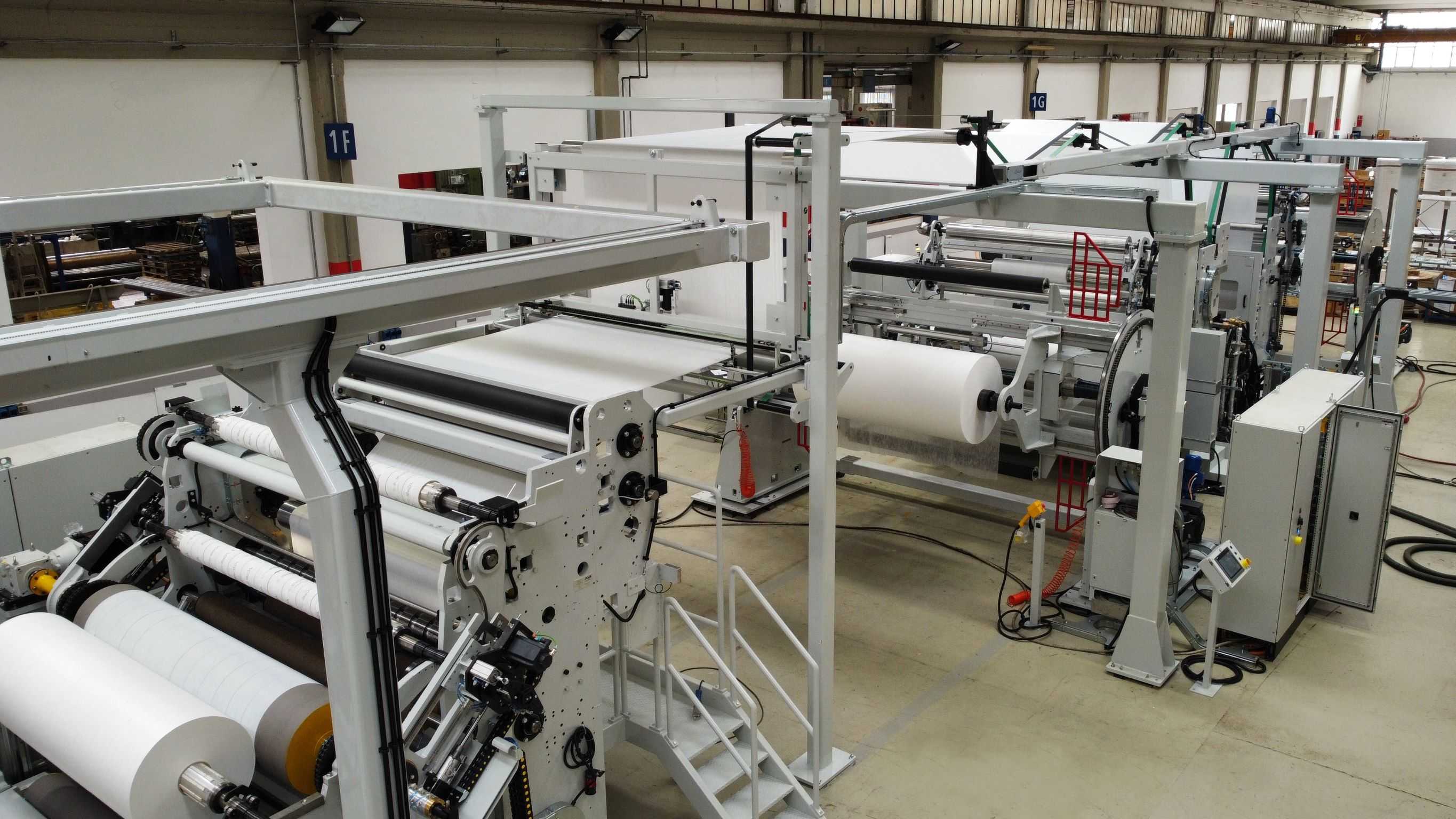
By lamination we mean the production process of a material in several layers, whose properties are the result of the combination of the physical and mechanical characteristics of each layer.
In our case, lamination is the union of two or more layers, of which at least one is a layer of nonwoven, with the goal of obtaining better resistance, stability, acoustic insulation, appearance or other properties.
The bonding, carried out through the use of adhesives (or heat) and pressure, give life to nonwoven products with one waterproof layer that are breathable, soft, comfortable and suitable for printing.
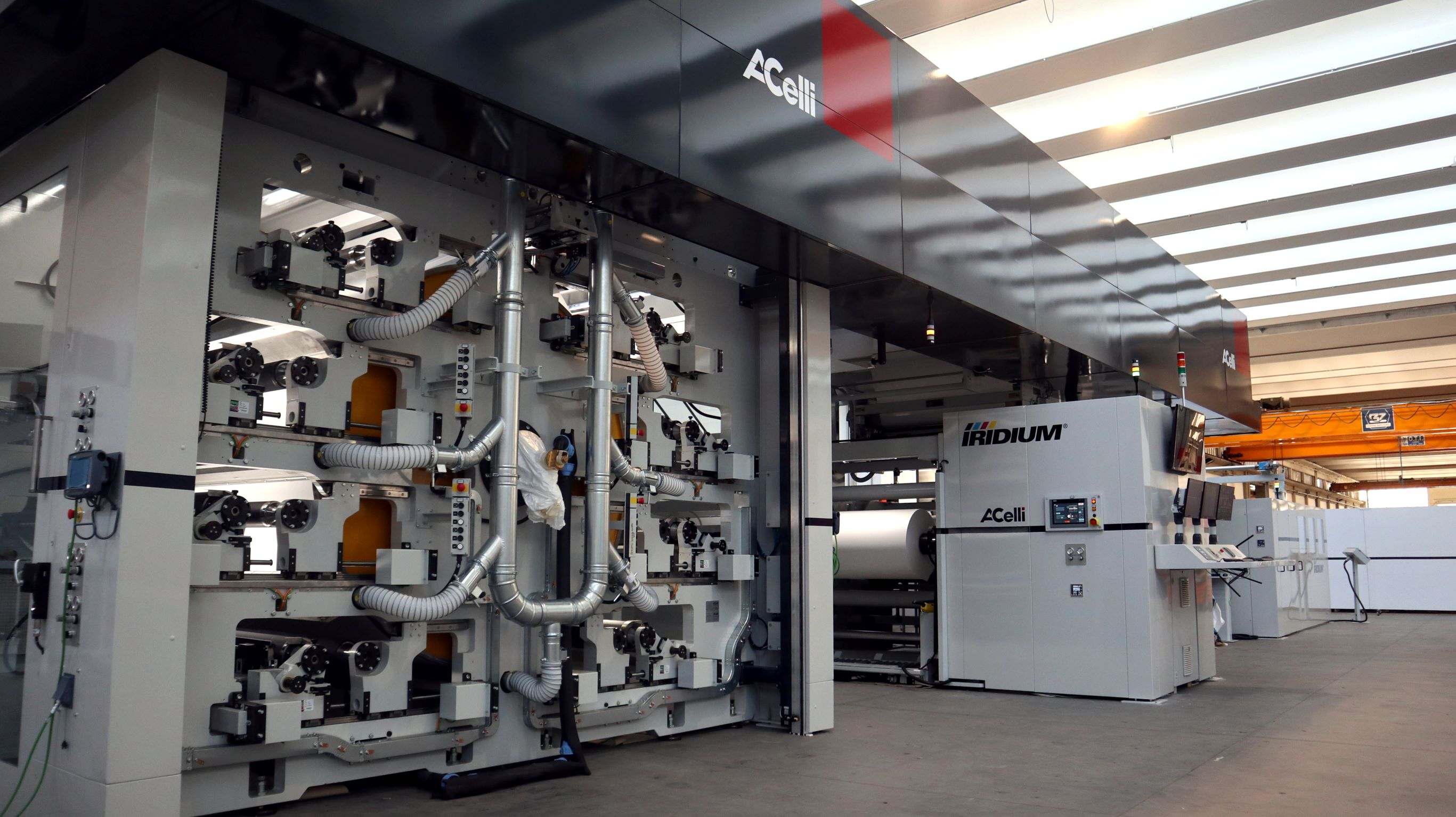
Flexography is the most widely used printing technique in the treatment of nonwoven. To obtain a good result, however, it is necessary to face a series of problems that may arise during the printing process.
One of the aspects to pay more attention to is the variability of the print repeat lenght, which can be affected by the flexographic printer itself and by the machines upstream and downstream. The challenge is to obtain a consistant print repeat lenght, from the outer diameter of the reel to the core: otherwise, the entire production batch must be discarded with huge costs for the manufacturer.
The print repeat lenght can also vary depending on the dimensions of the reel, as the tension changes according to the diameter.
The ageing of the material can also affect the print repeat lenght because it can cause stretching in the external coils of the printed reel. The same phenomenon also occurs on lamination machines.
Strictly related to the problem of variability of print repeat lenght, is the need to achieve and maintain a correct tension of the web during the entire printing process, which also involves the machines upstream (unwinders) and downstream (winders) of the flexographic printer.
A correct and constant tension is essential to avoid problems such as shrinking or stretching of the material, which cause an elongation of the print repeat lenght. Therefore, the machines involved in the printing process must work in harmony to give a final product of high quality, correctly printed and wound.
Another aspect to consider in flexographic printing is the choice of ink: whether it is solvent-based, water-based or UV-curable, it must adhere well to the substrate, dry correctly with respect to the print speed and be able to resist the heat used during any subsequent lamination process.
Lately, greater use is made of water-based inks because they are safer and more sustainable, the costs associated to monitoring Volatile Organic Compounds (VOCs) are lower and in many areas of the world the use of solvent-based ink has been discouraged.
Another frequent problem with flexographic printing is the longitudinal cutting phase. When we print a product that must be subsequently cut into a set number of strips of a defined width with the goal of obtaining smaller reels (e.g. for products such as diapers or sanitary pads), it is necessary to align and centre the printing with respect to the product to achieve the desired result and avoid errors, with consequent waste of material.
In the hygiene-sanitary sector the print runs are long, and the number of setup is low. The flexographic printing machine, in this kind of production, works non-stop for extended periods, reaching even 24 hours straight.
This can lead to a series of problems, such as, for example, heating of the shoulders caused by the temperature of the motors, which can cause geometric deformations in the printed image. For this reason, one of the main requests is to guarantee the consistency and the stability of the performance of the printing machine for extended periods of time.
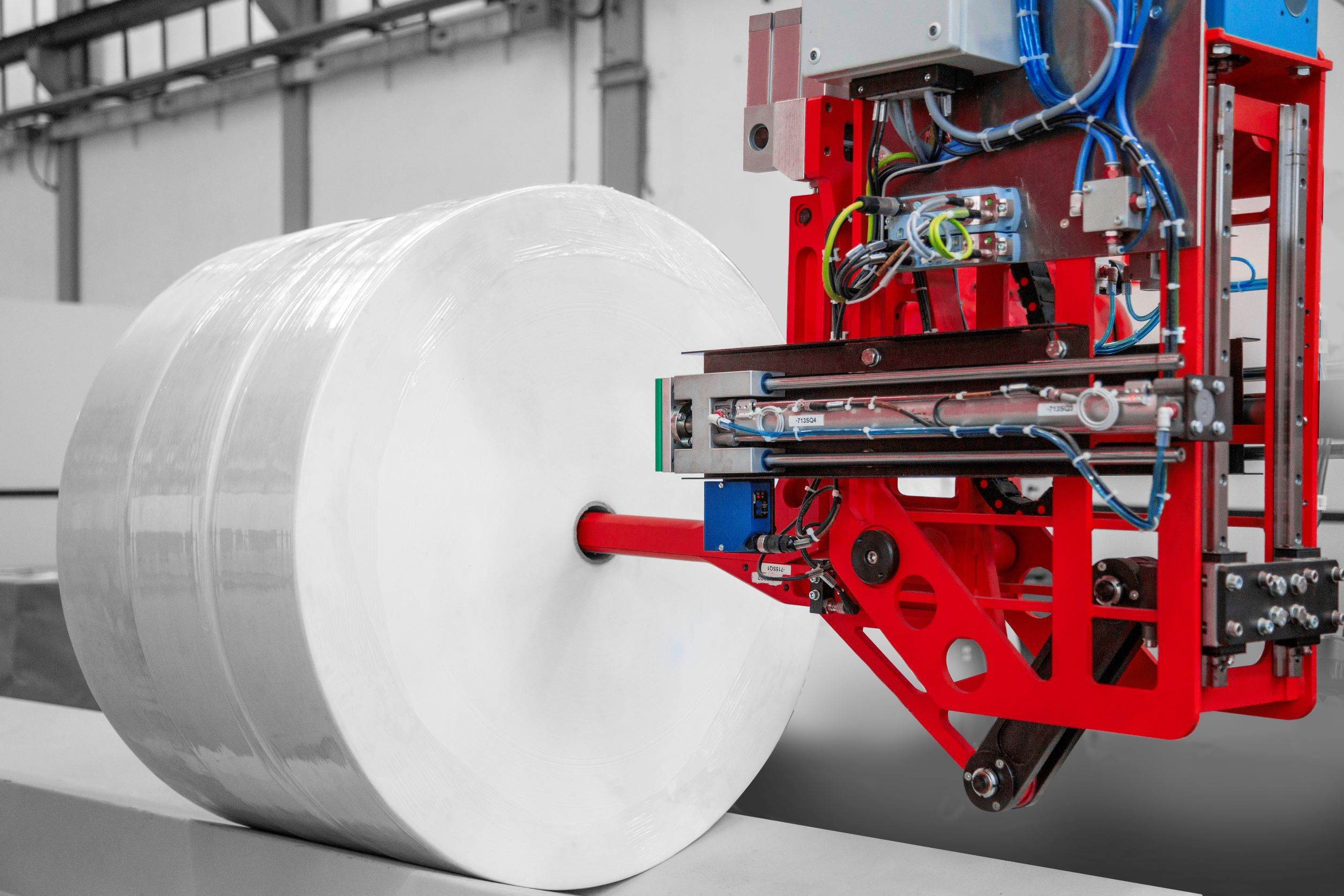
Once the reel has been obtained, the process continues with the packaging phase, an activity which, thanks to the technological evolution, can benefit from numerous advantages offered by the automated solutions available on the market.
These lead to significant savings in terms of time and money compared to the traditional manual operations, in the possibility of managing any peak or stall of production thanks to 24/7 operation and in the reduced need for human intervention, with a reduction in the risk of error and with the possibility of using staff to conduct more value-added work.
An automatic packaging system also allows to calibrate space with great precision in the installation phase, to the point of using just 10-20% of the space usually required in the factory in case of manual operations.
To achieve maximum performance, an automatic packaging system needs to be customisable: only a solution tailored to the needs of the specific production line can fully meet the needs of the customer. In short, an automatic packaging system should be able to conduct some (or even all) of the following operations:
If you want to aim for maximum process efficiency and the best possible quality of the final product, an automatic packaging system is the best solution to ensure that the reel arrives to the end customer exactly as it came out from the production line.
Labelling is a complex and demanding operation which is often underestimated. The basis of the process is integration with the ERP business system: this is the only way to be sure of correctly satisfying the order with packaging that meets the requests.
The labels, printed and positioned on the core, on the external surface of the single reel and on the reel bundle, gather all the details on the product detected during the single packaging phases. By doing so, the label allows to know the entire history of the reel, which is an essential aspect for tracing and certifying the value chain.
It is also possible to adopt a label monitoring system based on the use of cameras. Positioned along the packaging line, they can read the labels and compare the data found with those present in the database, checking actual correspondence and take action on the production in case of any inconsistencies.
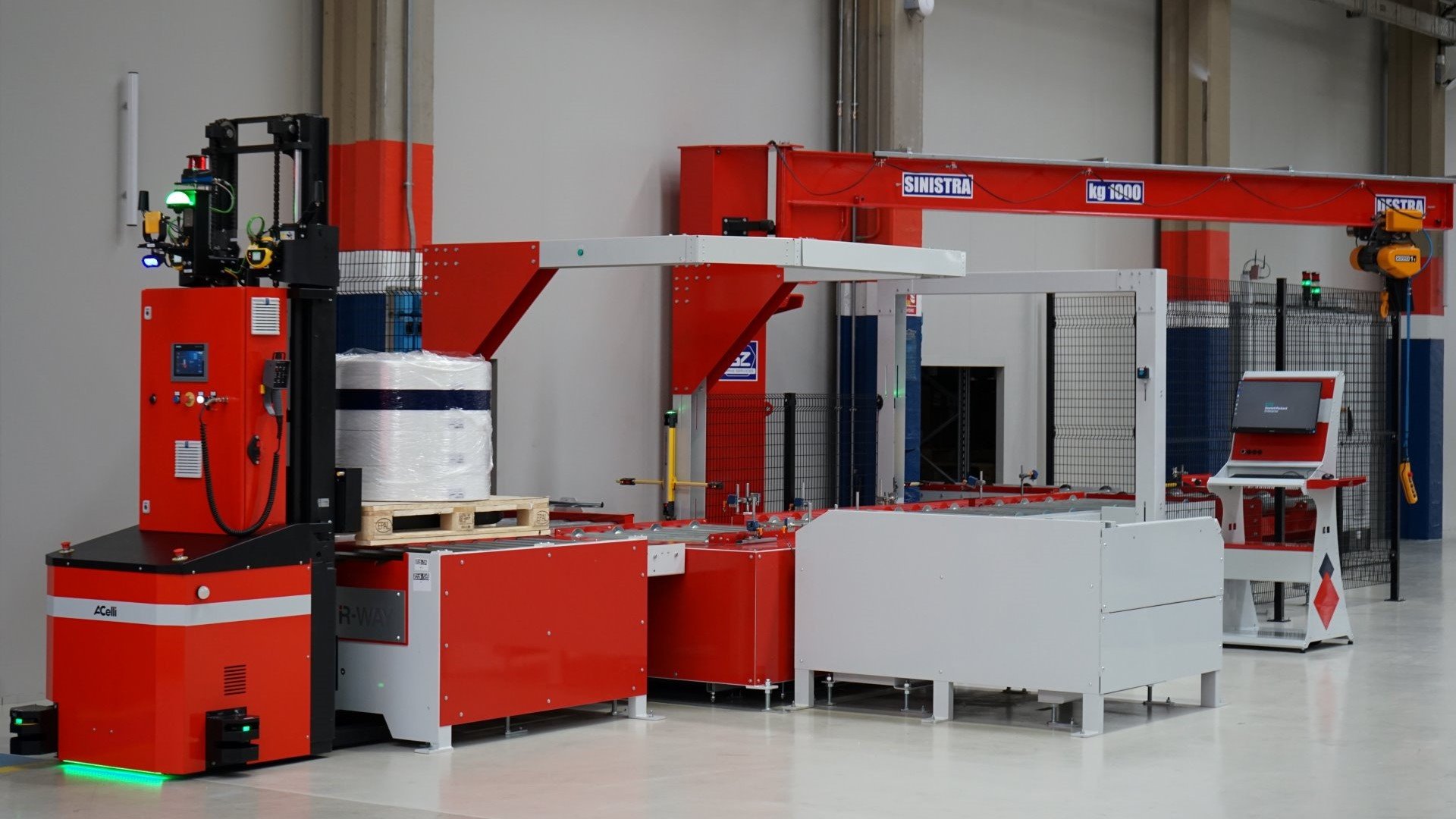
The warehouse plays an increasingly strategic role for a production company. It is no longer the place where goods are stored for long periods of time: it has become a dynamic environment where optimisation of the activities must go hand in hand with that of the occupied space. To satisfy increasingly demanding customers, the offers have expanded and deepened.
The warehouse could therefore only be the place of choice for the use of tools that allow simpler traceability of the products, a more agile handling of the goods and a better management of space. Tools such as the AGVs (Automatic Guided Vehicles), driverless autonomous vehicles, and the automated warehouses.
Created to replace horizontal conveyors, AGVs have undergone a notable evolution which has led them to a considerable differentiation in terms of technology and uses. Today, there are no limits to their uses, just as there is no rigid classification but models which differ in terms of driving system, load capacity, tools, power, and movement capacity in relation to the purpose of use.
Today, warehouse personnel work primarily using digital devices of the latest generation, remotely managing automatic warehouses and AGVs.
Stacker cranes make it possible to exploit the warehouse in all its volume by significantly increasing the total storage volume or reducing the space occupied on the ground by up to 90% compared to a traditional layout, for the same stored product.
Adopting AGVs changes the processes of warehouse management and improves them significantly, with a rapid return on the investment made. The immediate achievable advantages include:
As we will soon see in a case study dedicated to a customer who adopted all the above mentioned solutions, contacting a single supplier such as A.Celli for the entire end line, including packaging and management of the automatic warehouse, is the best choice to ensure perfect integration of all the machines present and the optimisation of the performances of the line based on the type of product manufactured.
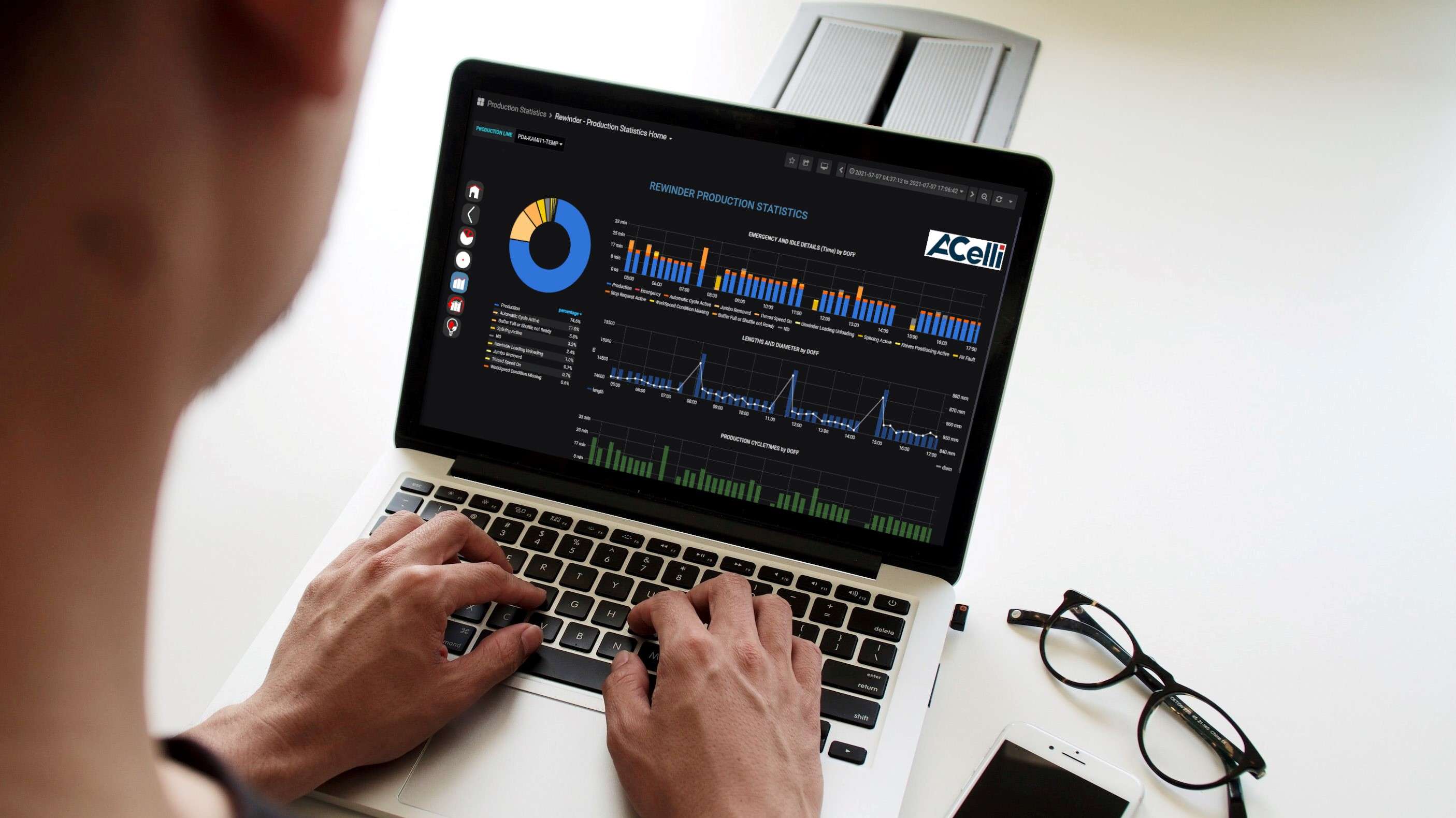
Changing customer demands and the instability of the market also force those working in the nonwoven sector to have a certain productive flexibility whilst reducing costs, optimising processes, and limiting waste and consumption. All, obviously, without compromising the quality of end products.
Significant help comes from the Industry 4.0 thanks to which it is now possible, for example, to monitor any system in real time, anytime and anywhere, drastically improve production and obtain a precise cost allocation per meter of nonwoven product.
It all begins with the collection of data from each single machine of each system by means of dedicated sensors, which provide accurate indications on the numerous parameters of each single phase of the production process.
The data thus collected, integrated with the data from other systems such as management software, are subsequently analysed using Artificial Intelligence and machine learning in a way that provides countless information useful for the strategic and operational decision-making processes, such as real-time determination of the operational efficiency of each machine, with the possibility to improve the O.E.E. and the quality of the product obtained, and the ability to compare the performance between various lines and different plants.
We will briefly analyse some of the possible applications of the digital solutions in the production of nonwoven.
To increase production whilst maintaining a high quality level of finished product reels, it is now possible to use a tool to manage and optimise vibrations based on machine learning algorithms and artificial intelligence, such as our A.Celli Smart Ramp-Up.
This solution makes it possible to obtain an increase in production speed and rewinding greater than the values defined by the operator (up to 5%) while avoiding the onset of phenomena of vibrational instability due to the main rotating components of the machine.
Having data on machine operation allows to keep its condition under constant control. This allows to perform predictive maintenance, i.e., to identify and monitor specific parameters on the remaining useful life of components subject to wear to programme maintenance work before a fault occurs.
Continuous monitoring offers the confidence of having machines that always work at their best with optimal performance and efficiency.
Today, companies produce an enormous quantity of data relating to the production of each specific product, from the raw materials used and the processes conducted up to the shipment stage.
To guarantee compliance of each production phase with the highest quality standards it is possible to use systems to track and store the information and characteristics of the reel, thanks to an extremely scalable and flexible architecture such as our A.Celli iREEL. The solution we offer, based on RFID tags applied to the cores of the nonwoven reels, provides each product with an identification code able to certify both the quality of the product and that of each phase of the value chain upstream.
Contact us if you want to know more about how to improve the different stages of the “journey” of the nonwoven reel, from the winding and unwinding process to the handling phase in the warehouse and storage, without forgetting the advantages of the digital transformation of your production system.
Our experts will be available for a free, non-binding consultation to discuss how to optimise your production of nonwoven!